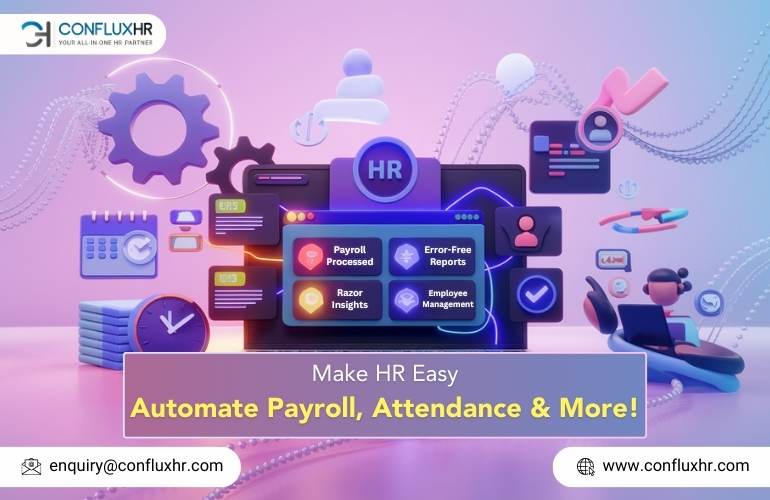Did you know that businesses using HRMS software reduce HR errors by up to 30% and improve overall efficiency? In the fast-paced environment of Indian small businesses, HR operations often face challenges due to manual processes, scattered records, and outdated tools. From managing payroll to tracking attendance and maintaining compliance, small business HR teams juggle multiple roles daily. The solution? Modern HR automation software tailored to the needs of small and growing enterprises.
Cloud-based HRMS solutions and employee management software empower businesses to automate repetitive tasks, streamline workflows, and ensure error-free HR operations. For Indian SMBs, where growth is rapid and resources are limited, investing in cost-effective HR solutions is no longer optional—it’s urgent. Let’s explore why HRMS is essential, its core features, and how it can transform your workforce management in 2025.
Why HRMS Solutions Are a Necessity for Small Businesses
Managing HR processes manually is not sustainable in today’s competitive environment. Whether it’s payroll errors, tracking leaves, or ensuring labor law compliance, small businesses face mounting HR challenges that hinder productivity.
Increasing Complexity in HR Operations
Manual processes are prone to errors, leading to inefficiencies. For growing businesses, managing payroll, leaves, and compliance becomes complex as teams expand.
- Stat: “40% of small businesses save time and resources using automated attendance and payroll systems.”
Affordable Cloud-Based HRMS Solutions
Unlike traditional systems, cloud-based HRMS solutions offer scalability and accessibility at affordable pricing. These systems allow real-time updates, making HR management seamless for small businesses.
Example: A Mumbai-based retail business implemented a cloud-based HRMS solution and reduced payroll errors by 35%, saving 10+ hours weekly for their HR team.
Key Features to Look for in HRMS Software
- Leave and Attendance Management
Leave and attendance management tools automate approvals, monitor leaves, and track attendance in real time. These systems integrate with compliance management systems to ensure adherence to labor laws.
- Visual dashboards help HR teams analyze absenteeism trends and improve workforce management.
- Payroll Automation
Simplify salary disbursement with automated payroll systems for small business. Accurate calculations ensure timely salary payments while complying with tax regulations.
- Features like simplified payroll processing reduce errors and streamline disbursements.
- Employee Self-Service Portals
Empower employees to manage their profiles, access payslips, apply for leaves, and update records through employee self-service portals.
- Reduces HR workload and improves employee satisfaction.
- Performance Management Software
Track goals, performance reviews, and feedback effectively with performance management software.
- Enables efficient HR performance tracking for better evaluations and talent growth.
- HR Analytics for Small Businesses
HR analytics for small businesses provides actionable insights into workforce productivity, employee turnover, and engagement trends.
- Data-driven decisions help optimize hiring, retention, and operations.
Benefits of Using HRMS Software for Small Businesses
- Streamlined HR Operations
Automating repetitive tasks with HR automation software reduces errors and enhances productivity. HR teams can focus on strategic growth instead of manual paperwork.
- Improved Compliance
HR compliance tools ensure businesses adhere to labor laws and payroll regulations, minimizing legal risks.
- Stat: “Small businesses using compliance automation tools report 20% fewer legal issues.”
- Time and Cost Savings
By integrating cloud-based HRMS solutions, businesses save up to 25% of HR management time, cutting operational costs significantly.
- Example: A Delhi-based logistics startup reduced manual data entry errors by 50% using automated leave and attendance management tools.
- Better Employee Management
With employee management software and workforce management tools, tracking performance, attendance, and records becomes easier and more efficient.
Addressing Common HR Challenges for Small Businesses
- Manual Processes
Manual HR tasks are time-consuming and error-prone. Implementing integrated HR automation systems can streamline operations, reduce paperwork, and minimize errors.
- Tracking Employee Performance
Using HR performance tracking tools, businesses can automate reviews and feedback processes to ensure consistent evaluations.
- Leave and Payroll Issues
Manual leave approvals and payroll mismanagement lead to frustration. Leave and attendance management tools ensure transparency and accuracy.
Example: An Ahmedabad-based manufacturing company cut down payroll processing time by 40% using automated payroll systems.
How to Choose the Right HRMS Software
When selecting HRMS software, small businesses must prioritize:
- Ease of Use: Choose a user-friendly system that requires minimal training.
- Cost-Effectiveness: Opt for cost-effective HR solutions with scalable pricing.
- Integration: Ensure the tool integrates with employee records management and payroll systems.
- Advanced Features: Look for talent acquisition and onboarding and robust HR analytics for small businesses.
Real-Life Example: A Pune-based tech startup improved HR efficiency by 60% using a scalable HRMS with advanced payroll and performance management features.
Future Trends in HRMS Software for Small Businesses
- AI-Driven HR Analytics
AI will enable smarter HR analytics for small businesses, offering predictive insights to improve hiring and retention.
- Growth of Cloud-Based HRMS Solutions
The adoption of cloud-based HRMS solutions will continue to grow, enabling remote accessibility and real-time workforce updates.
- Enhanced Talent Acquisition and Onboarding
Talent acquisition and onboarding tools will streamline the hiring process, ensuring businesses attract and retain the best talent.
- Stat: “By 2025, 65% of SMBs will use AI-powered HR tools to improve workforce productivity.”
Conclusion
For small businesses in India, adopting HRMS software is not just about managing HR tasks—it’s about driving growth, improving compliance, and enhancing employee satisfaction. Whether it’s automating payroll, simplifying attendance management, or leveraging HR analytics for small businesses, the benefits of investing in modern HR automation software are undeniable.
In 2025, businesses that embrace cost-effective HR solutions and integrated HR automation systems will gain a competitive edge in workforce management. Platforms like ConfluxHR are designed to meet the unique needs of Indian SMBs, helping them streamline operations and scale efficiently.






